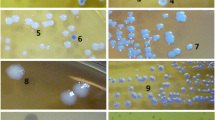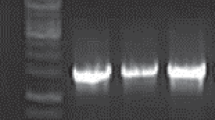Summary
A rapid and simple technique utilizing the APIZYM enzymatic patterns complemented with arginine dihydrolase and citratase was developed for species differentiation of 40 lactic acid bacteria relevant to the dairy industry.Streptococcus species in general produced no β-galactosidase, except forStreptococcus thermophilus. Lactobacillus species showed strong aminopeptidases and galactosidases but contained no arginine dihydrolase and citratase. Among the group N-streptococci,Streptococcus diacetylactis produced citratase, whereasStreptococcus cremoris differed by the production of butyrate esterase.Streptococcus faecalis was readily distinguishable fromStreptococcus lactis by butyrate esterase activity that was the basis of the differential agar developed. Heterofermentative lactobacilli differed from homofermentative lactobacilli in possessing arginine dihydrolase and citratase but by not producing leucine-aminopeptidase.
Similar content being viewed by others
References
Bouillanne, C. and M.H. Desmajeaud. 1980. Etude de quelques caractères de souches deS. thermophilis utilisées en fabrication de yoghourt et proposition d'une méthode de classement. Le Lait, 60: 458–473.
Clark, W.S. and G.W. Reinbold. 1966. Enterococci in young cheddar cheese. J. Dairy Sci. 49: 1214–1218.
Cohen, B., M.J. Hudson and M.J. Hill. 1980. Comparison of the API20A. APIZYM and conventional methods for the identification of anaerobic bacteria. J. Med. Microbiol. 13, 8.
Diebel, R.H. and H.W. Seeley. 1978. Family, Streptococcaceae. In: Bergey's Manual of Determinative Bacteriology, (Buchanan, R.E. and N.E. Gibbons, eds.), 8th Edn., Williams and Wilkins Co., Baltimore.
Gilliland, S.E. and M.L. Speck. 1977. Use of the Minitek system for characterizing lactobacilli. Appl. Environ. Microbiol. 33: 1289–1292.
Harvey, R.J. and E. B. Collins. 1963. The citratase ofStreptococcus diacetylactis. J. Biol. Chem. 238: 2648–2653.
Hemme, D., D. Wahl and M. Nardi. 1980. Variations de l'équipement enzymatique deStreptococcus thermophilus. Le Lait, 60: 111–129.
Humble, M.W., A. King and I. Phillips, 1977. APIZYM: a simple rapid system for the detection of bacterial enzymes. J. Clin. Pathol. 30: 275–277.
Huggins, A.R. 1984. Progress in dairy starter culture technology. Food Technol. 38(6): 41–50.
Kempler, G.M. and L.L. McKay. 1980. Improved medium for detecting of citrate-fermentingStreptococcus lactis subsp.diacetylactis. Appl. Environ. Microbiol. 39: 926–927.
Law, B.A. and M.E. Sharpe. 1978. Streptococci in the dairy industry. Streptococci, (Skinner, F.A. and L.B. Quesnel, eds.), pp. 263–278, Academic Press, London.
Lee, B.H. and R.E. Simard. 1984. Three systems for biochemical characterizations of lactobacilli associated with meat spoilage. J. Food Prot. 47: 937–942.
McKay, L.L. 1983. Functional properties of plasmids in lactic streptococci. Antonie Van Leeuwenhoek J. Microbiol. Serol. 49: 259–274.
Matteuzzi, D. 1972. Lactic acid production in milk and DNA homology relationships in the speciesLactobacillus jugurt. Can. J. Microbiol. 18: 1893–1895.
Paquin, C. and J. Goulet. 1984. Séparation d'un mélange de streptocoques par adsorption sélective. Can. Inst. Food Sci. Technol. J. 17(3): 33 (abstract).
Prentice, G.A. and J.V. Brown. 1983. The microbiology of cheddar cheese manufacture. Dairy Ind. Intern. 48: 23–26.
Reddy, M.S., E.R. Vedamuthu, C.J. Washam and G.W. Reinbold. 1969. Differential agar medium for separatingStreptococcus lactis andStreptococcus cremoris. Appl. Microbiol. 18: 755–759.
Robinson, R.K. 1983. Starter cultures for milk and meat processing. In: Biotechnology, Vol. 3 (Rehm, H.J. and G. Reed, eds.), pp. 192–202, Verlag chemie, Weinheim.
Roissert, H.B. 1983. Que sont les bactéries lactiques? La technique laitière. No. 979, 41–47.
Somkuti, G.A. and D.H. Steinberg. 1979. Adaptability ofStreptococcus thermophilus to lactose, glucose and galactose. J. Food Prot. 42: 885–887.
Thornley, M.J. 1960. The differentiation ofPseudomonas from other gram-negative bacteria on the basis of arginine metabolism. J. Appl. Bacteriol. 23: 37–52.
Author information
Authors and Affiliations
Rights and permissions
About this article
Cite this article
Lee, B.H., Haché, S. & Simard, R.E. A rapid method for differentiation of dairy lactic acid bacteria by enzyme systems. Journal of Industrial Microbiology 1, 209–217 (1986). https://doi.org/10.1007/BF01569274
Received:
Revised:
Accepted:
Issue Date:
DOI: https://doi.org/10.1007/BF01569274




